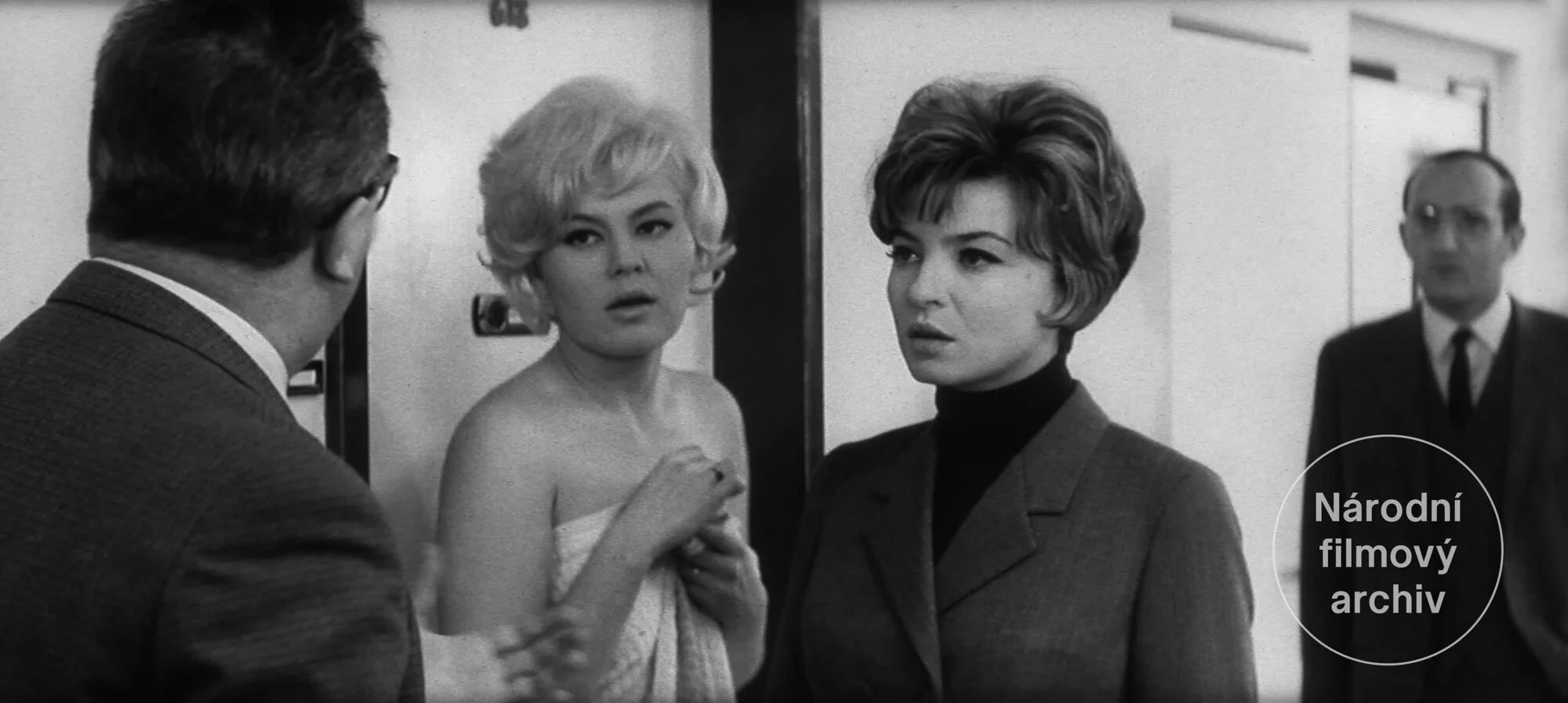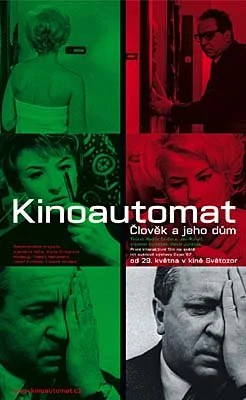Kino-Automat Decision Cinema
One of the more avant-garde film options at Expo ‘74 was “Kino-Automat Decision Cinema,” an interactive film that had debuted to great acclaim at the Montreal Expo in ‘67. The film was written and directed by Radúz Činčera and starred Miroslav Horníček and had been dubbed into English for international audiences. The English version of the film was sometimes billed in Expo ‘74 materials as “A Man And His House,” but most sources simply refer to it as Kino-Automat (sometimes given as “Kinoautomat” or “Kino-automat”). It was screened in a special theater within the Washington State Pavilion.
Czech poster for Kinoautomat.
The film followed the story of Petr Novák, an “everyman” character. It opens with a scene of Petr’s apartment in flames, then flashes back to earlier in the day. At nine crucial points in the story, the film would pause and a live moderator would come out to address the audience, asking them to use the red and green buttons on their theater seats to choose Petr’s next move. For instance, at one point a woman wrapped in a towel knocks on Petr’s door, asking for help because she is locked out of her apartment. Knowing that Petr’s wife is about to come home, the audience can vote to have Petr let her in, or can vote to deny her entry. Behind the scenes, a projectionist switched between two different film projectors with different versions of the film to reflect the audience’s decision. The live moderators at Expo ‘74 were two young women who had recently graduated from the Fort Wright College’s drama department, Carlotta Schoch and Patt Blem.
What some audience members may not have realized is that the apartment fire shown at the beginning of the film was unavoidable regardless of the choices made by the audience. This was part of Činčera’s vision and has been interpreted as a satire of democracy, a satire of determinism, or a statement on the futility of choice.
Regardless of its underlying message, the format was popular among audiences, and Hollywood was interested in making more films using the “decision cinema” concept. Unfortunately, Kine-Automat was appreciated much more overseas than in its home country. The film was banned in 1972 by the Communist Party of Czechoslovakia for unclear ideological reasons. Being rejected by the Party was essentially the death of Kino-Automat, as explained by Czech cinema operator Ivo Anderle: "Originally at the end of the 60s, all the big Hollywood studios were asking Mr Cincera for Kinoautomat licensing. Unfortunately in the Socialist era this was not possible, it was the property of the state which did not care so much about selling it, so Kinoautomat was not lucky."
A children’s version of decision cinema, consisting of several cartoons, was also shown intermittently in the Kino-Automat theater. In this case, the choices were spelled out as “good” or “bad” and the moderators were dressed as clowns. They were played by Fort Wright College students Jack Jensen and Bill Murphy.
Expo ‘74 KinoAutomat Flyer
From the Official Souvenir Program, p. 128:
KINO-AUTOMAT IS SPACE AGE CINEMA
Viewers at Kino-automat, new kind of space-age cinema in Washington State Pavilion, have the chance to play Director.
At freeze-frame intervals during the 70-minute color comedy about a bumbling Everyman, live actors ask viewers to vote on further action by pressing electronic buttons on one of the specially-equipped theatre’s 400 seats.
Did Everyman cause his apartment-house fire? Should he crack his enemy over the head with a wine bottle?
Kino-automat, a presentation of Sterling Recreation Organization of Seattle, and Film Export Company of Prague, premiered with great success at Montreal’s Expo ‘67. This marks its West Coast debut.
Sterling has plans to bring Kino-automat to Seattle following Expo ‘74.
Raduz Cincera, leading Czech filmmaker, conceived the idea for decision cinema and produced the film.
Czech filmmakers and films in the past dozen years have been favorites at international film festivals: Milos Forman (“Loves of a Blonde,” “Taking Off”); Jiri Menzel (“Closely Watched Trains”), and Jan Kadar (“The Shop on Main Street”).
Kino-automat has profound implications for the study of decision-making processes and of mass behavior, not to mention for the assessment of entertainment tastes.
Several universities have made successful psycho-sociological studies in these areas.


